Welcome, fellow DIY lovers! I’m Zaid Ansari, and today I’m thrilled to walk you through a wonderfully simple, charming, and eco-friendly project: how to make jute hanging planter. If you live in a cozy Indian apartment or have limited balcony space like I do in my Mumbai flat, you’ll know how important it is to maximize greenery without clutter.

A few months ago, inspired by my love for sustainable living and wanting to add warmth to my balcony, I tried making a jute hanging planter for the very first time. It was an absolute game-changer! Using just natural jute rope and a terracotta pot, I created a piece that saved space, added rustic charm, and was kind to the planet. Plus, the gentle sway of plants hanging from the ceiling gives life to any small corner.
Jute hanging planters are perfect for Indian homes for a bunch of reasons:
- They save precious space in balconies, terraces, or even kitchen windows.
- Made with eco-friendly, biodegradable jute, they support sustainable living.
- The natural fiber brings in a rustic and aesthetic touch that suits Indian décor styles.
- They’re affordable and easy to make with simple materials available locally.
If you’ve been curious like me about how to make jute hanging planter or want to try a DIY jute hanging planter project, you’re in the right place! You can also explore more by checking out my DIY home décor and balcony gardening projects.
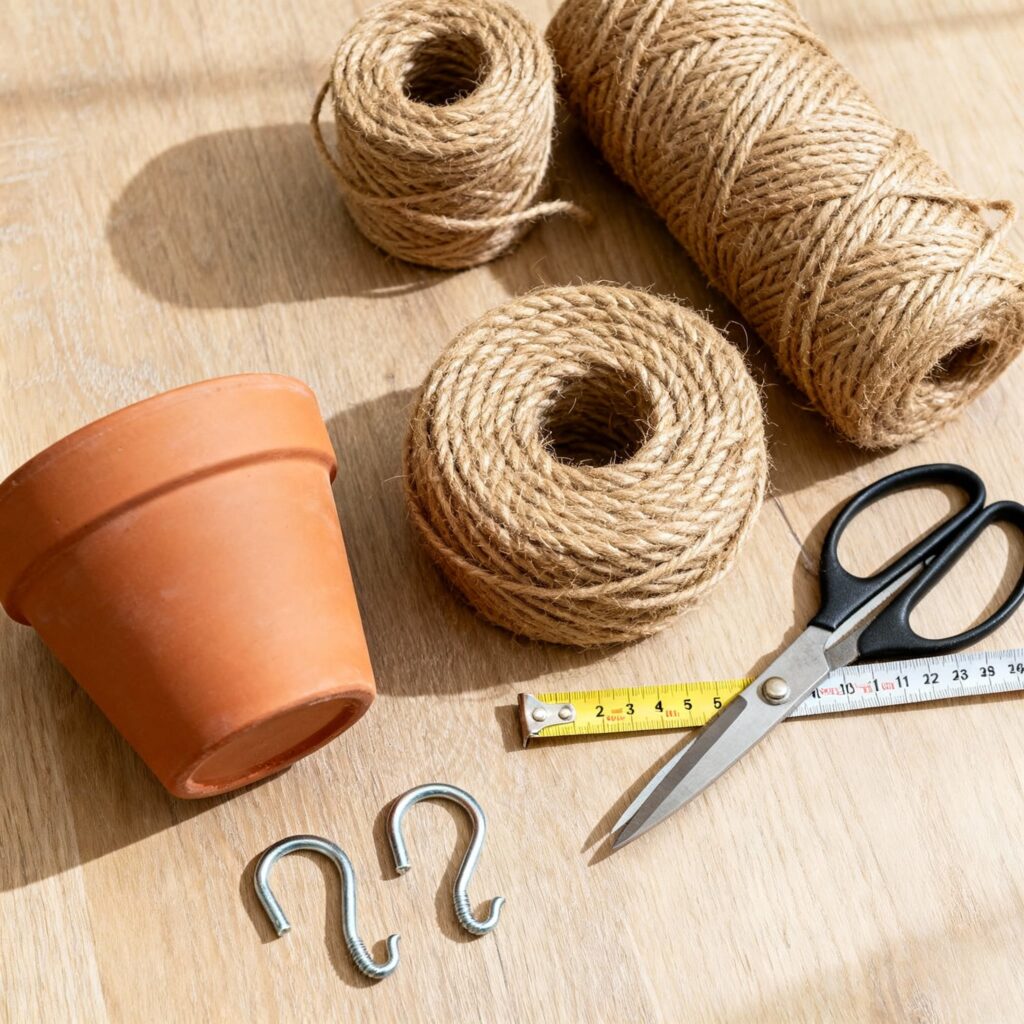
Materials Required for Your DIY Jute Hanging Planter
Before rolling up your sleeves, let’s gather everything you need. The great news is, most of these items are easily found in Indian markets or online, and you can even opt for budget-friendly alternatives!
Material list includes:
- Jute rope or string (5-10 mm thickness): Natural, brown jute rope is ideal. You’ll need about 10-15 meters, depending on your planter size. Look for it in hardware stores, craft shops, or online marketplaces like Amazon India or Flipkart.
- Plant pot: Terracotta or clay pots are the best choice for beginners. They’re porous, helping with plant health, and their rustic look pairs wonderfully with jute. Plastic pots are lighter but less aesthetic.
- Scissors: A sharp pair for clean cuts.
- Measuring tape or ruler: Accuracy helps avoid waste.
- Ceiling hooks or wall brackets: For safely hanging your planter.
- Optional decorative touches: Wooden beads, colorful threads, metal rings — these can enhance your planter’s look.
- Glue (optional): To prevent rope ends from fraying.
- Marker or chalk: To mark rope sections before knotting.

Budget-friendly tips:
- Repurpose old jute sacks or bags by cutting them into strips.
- Use cotton twine or hemp string as cheaper alternatives if you can’t find jute.
- Purchase rope in bulk from local markets like Chandni Chowk (Delhi) or Crawford Market (Mumbai) to save money.
- Be mindful of pot size; a small to medium pot (6-8 inches in diameter) is ideal for most beginners.
How to Make Jute Hanging Planter Step by Step
Now comes the fun part! Here’s a simple jute plant hanger tutorial with clear, friendly instructions on how to make jute hanging planter with string.

Step 1: Measure and Cut the Jute Rope
- Cut 4 pieces of jute rope, each approximately 3 meters long. Add an extra 10-15 cm for tying knots.
- Tip: Make sure all ropes are equal length, or your planter may hang unevenly.

Step 2: Tie the Top Loop
- Gather all 4 ropes, align their tops.
- Tie a strong knot 10-15 cm from the top, leaving a loop above the knot. This loop will be where you hang the planter.
- Adjust the loop size based on your ceiling hook or wall bracket.
Tip: Leave the loop loose enough to slide on your hook but tight enough to hold firm.
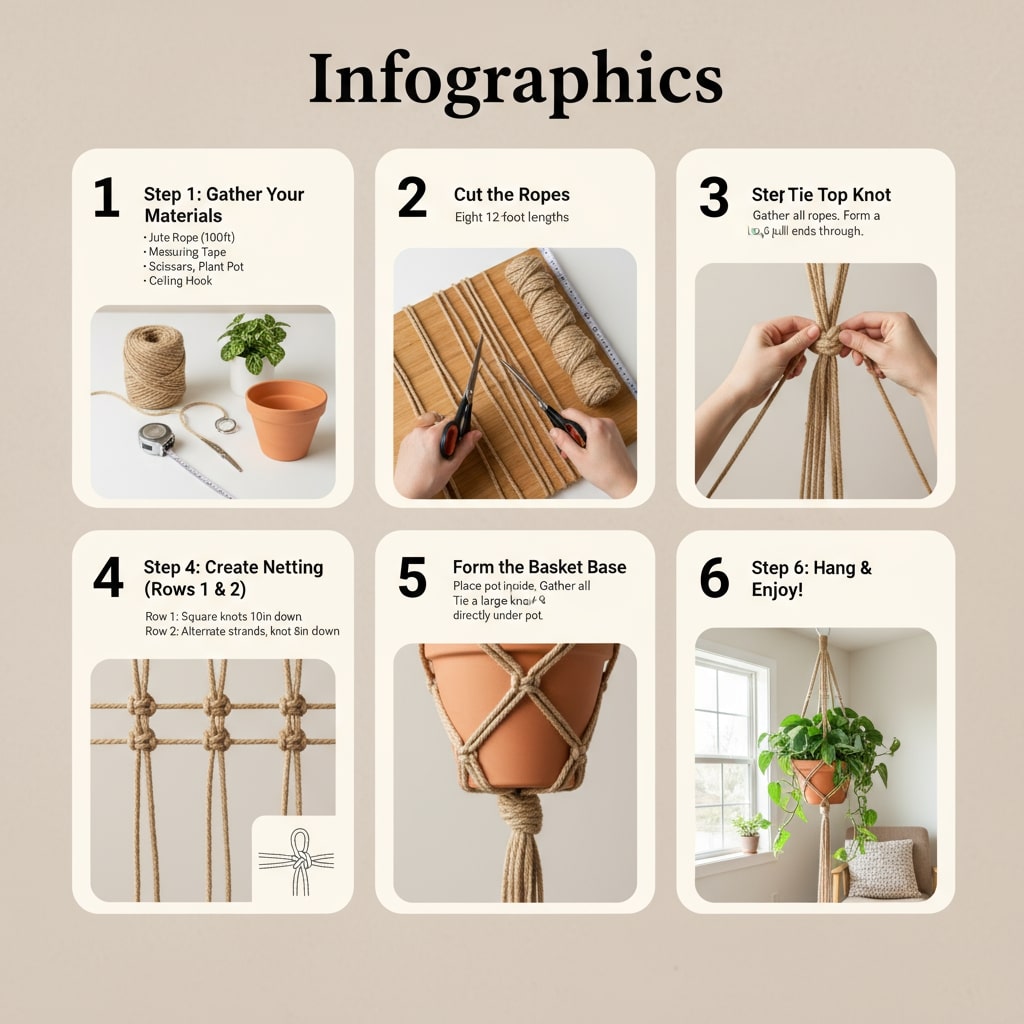
Step 3: Divide into Pairs and Tie First Knots
- Split the 4 ropes into 2 pairs of 2 strands.
- About 15 cm down from the top knot, tie a simple overhand knot on each pair.
- This starts the cradle for your pot.
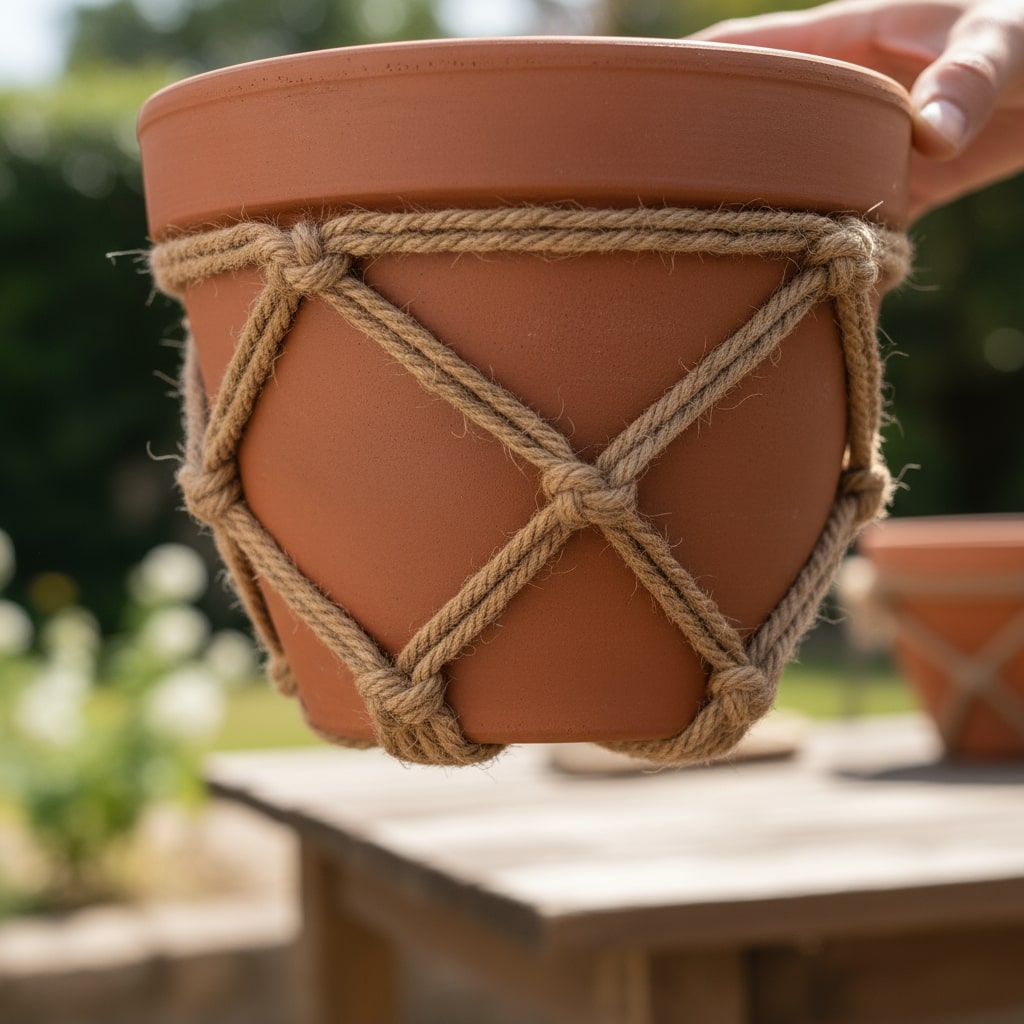
Step 4: Make the Net Pattern with Knots
- Now, take one strand from the left pair and one from the right pair.
- Tie these strands together 15-20 cm below the first knots. Repeat the same for the other side.
- Continue this X-shaped knot pattern every 15–20 cm until you reach a little above the pot’s base height.
Tip: Use square knots if you want a decorative macrame style look
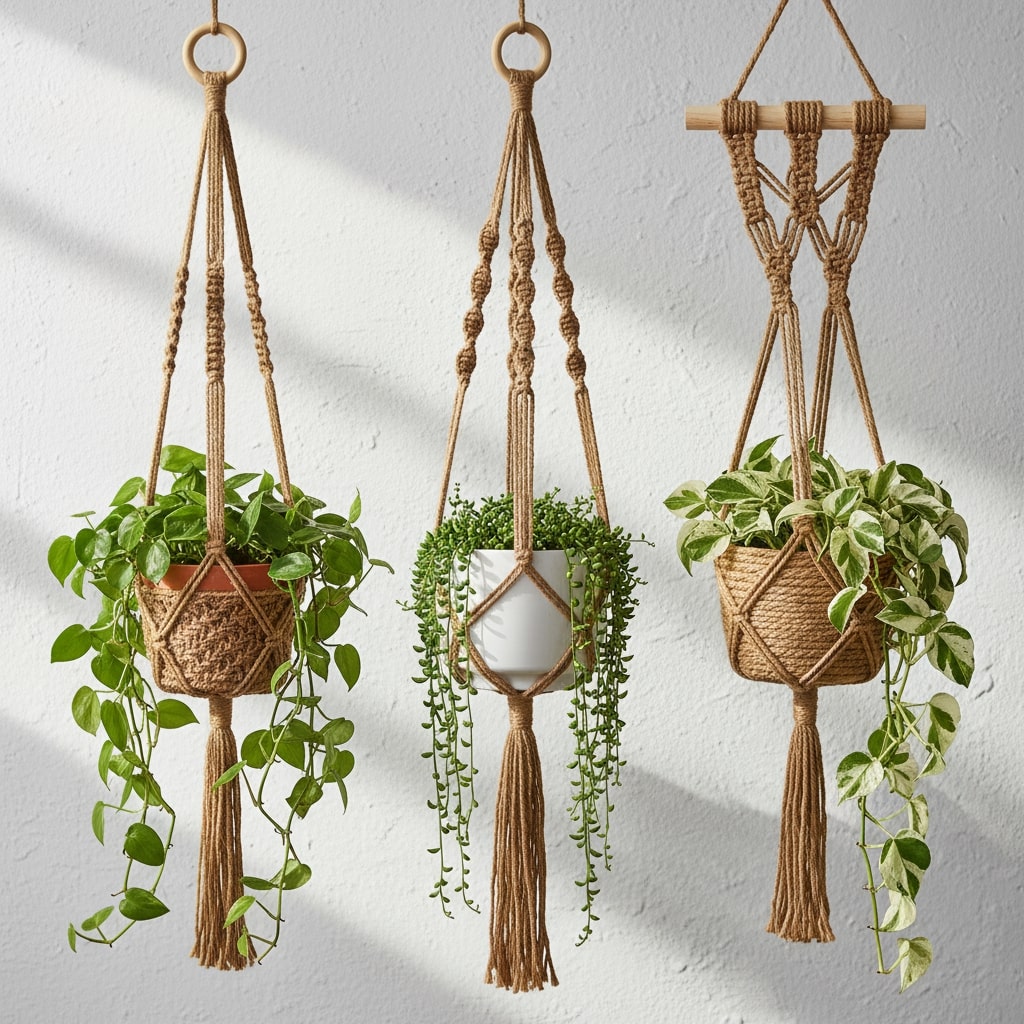
Step 5: Secure the Bottom Knot
- Bring all the loose ropes together just below the last row of knots.
- Tie a firm knot to hold the planter’s base.
- Cut off excess rope leaving about 5 cm tails.
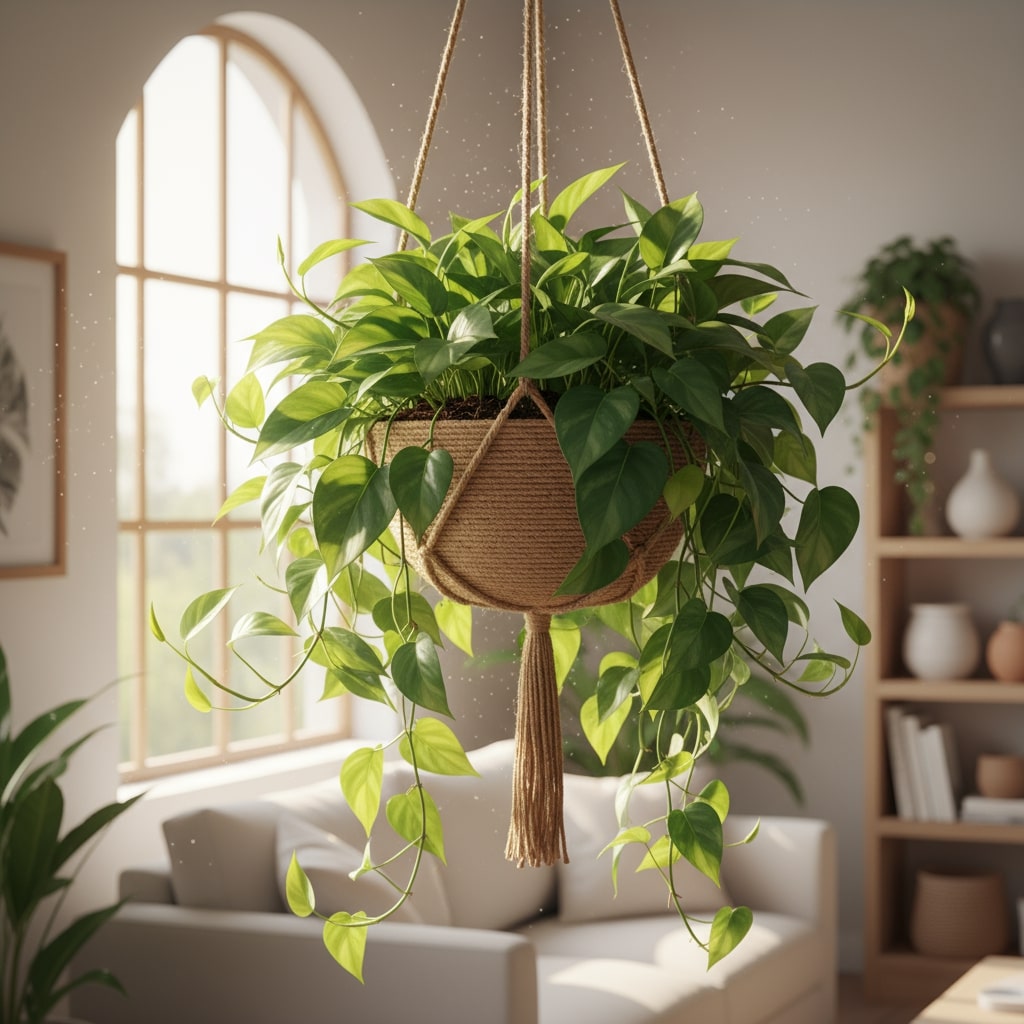
Step 6: Finishing Touches
- To prevent fraying, apply a small dab of glue on loose ends or carefully singe synthetic blends.
- Optionally, thread beads onto the ropes before knots for extra flair.
Step 7: Insert Your Pot and Hang
- Place your plant pot into the string cradle gently.
- Hook the loop onto your ceiling or wall hook.
- Check stability, especially if using heavier pots like terracotta.
Safety Note: For heavy pots, ensure strong ceiling hooks are used, preferably anchored into concrete or wood beams.

Design Variations You Can Try
After you master the basics of how to make jute hanging planter step by step, let’s explore some exciting variations!
- Simple jute plant hanger tutorial: Follow the basic knot pattern with plain jute rope for a minimalist, earthy feel.
- Macrame jute plant hanger: Incorporate classic macrame knots like square knots, spiral knots, and lark’s head knots for a boho-chic aesthetic. Great for adding texture and style!
- Colored/string combinations: Mix natural jute with colored cotton or synthetic strings to brighten your hanger and match your décor.
- Beaded & wooden ring embellishments: Add wooden beads or a metal ring at the top for a decorative upgrade.
- Braided jute rope styles: Instead of plain strands, braid your jute ropes before knotting to make stronger, chunkier designs.
- Multi-tier hanging planters: Combine multiple small hangers at different heights for a stylish vertical garden.
For tutorials on advanced macrame techniques, check out Simply Frayed’s Macrame Guide or The Inspired Hive’s Jute Macrame Tutorial.
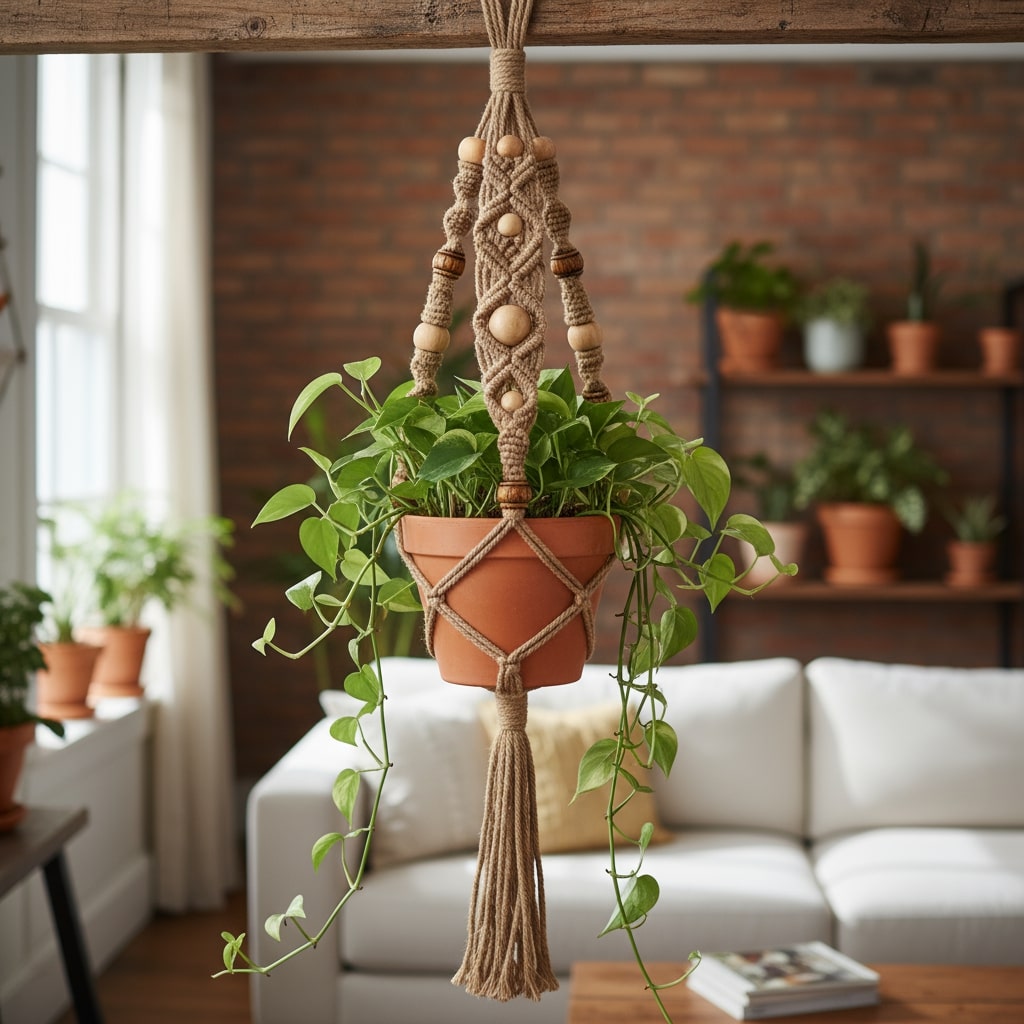
Maintenance Tips for Your Jute Hanging Planter in Indian Climate
Indian weather, especially the monsoon, can take a toll on natural fibers like jute. Here’s how to keep your jute rope plant hanger in tip-top shape:
- Avoid waterlogging: Use inner plastic or waterproof liners inside pot to prevent water dripping on jute.
- Protect during monsoon: Bring planters indoors on heavy rainy days or cover them.
- Dry jute regularly after rain exposure by placing planters in sunlight.
- Clean dust gently using a soft cloth or brush; do not soak the jute rope.
- Check knots occasionally, and retie if they loosen.
- Consider applying natural oils (like neem or coconut) once in a while to preserve rope flexibility.
- Choose hardy indoor plants like money plant, pothos, spider plant, or succulents that thrive in Indian homes and require less watering.
I once had to repair my own jute planter after a particularly harsh monsoon, and these precautions made a huge difference
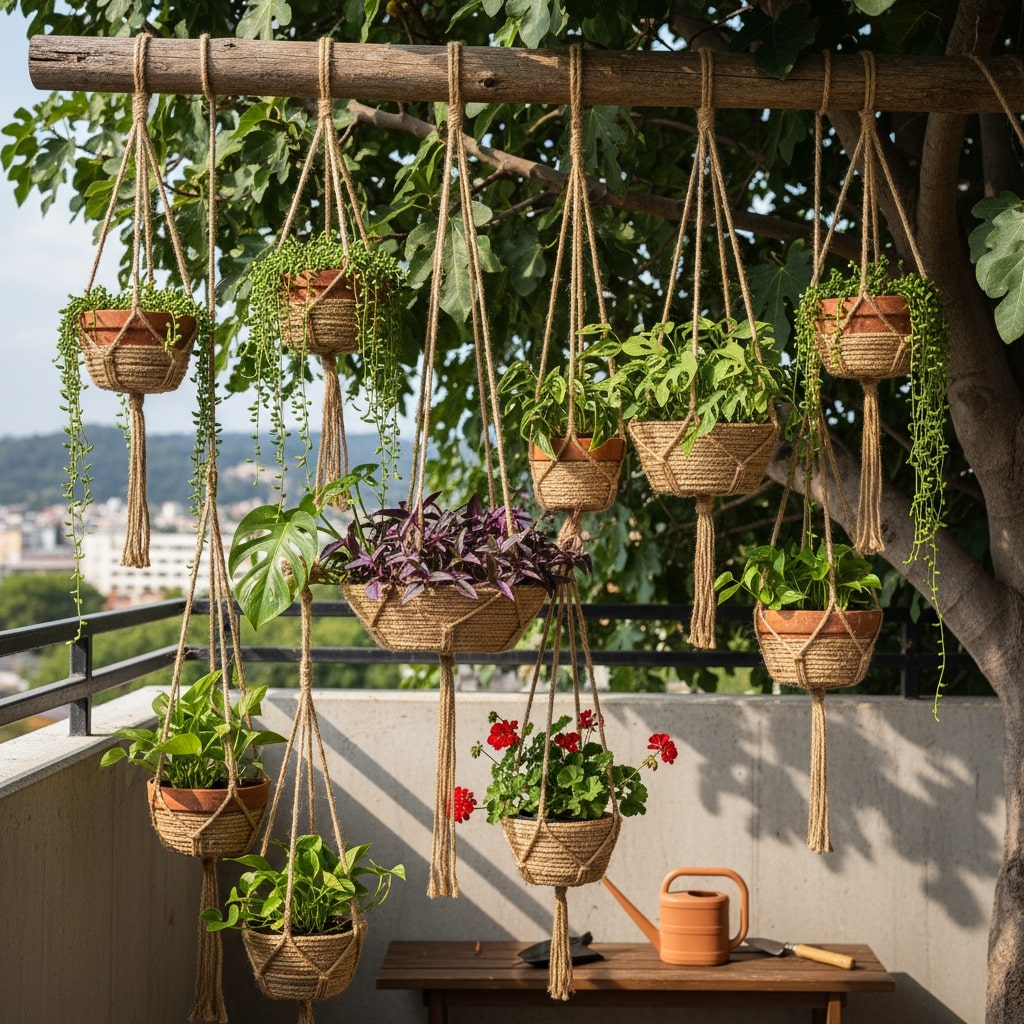
DIY Hacks & Budget Tips for Indian Beginners
Want to keep it wallet-friendly? Here are some hacks and budget tips for your jute rope plant hanger DIY:
- Repurpose old jute sacks or shopping bags by cutting them into long strips.
- Use affordable kitchen twine or cotton thread as an alternative to jute.
- Buy jute rope in bulk from local markets like Chandni Chowk or Crawford Market for great discounts.
- Use household items like fabric scraps, colored threads, or beads for decorations.
- No fancy measuring tape? Use your mobile phone or a piece of string as a ruler.
- Salvage ceiling hooks from old fixtures instead of buying new.
- Search for affordable pots or repurpose old containers.
- Combine leftover rope pieces from gifts or packaging instead of buying new rope.
For more budget-friendly décor guides, check out Budget DIY Home Décor Ideas

Recommended Affiliate Products for Your Project
To make your jute hanging planter journey smooth, here are some beginner-friendly materials I recommend, with helpful links for easy purchase:
| Product Name | Description | Price (₹) | Purchase Link |
|---|---|---|---|
| Natural Jute Rope 4mm | Durable and eco-friendly rope | ₹250 | Buy Now |
| Handmade Clay Pot (6 inch) | Perfect size with rustic charm | ₹300 | Buy Now |
| Macrame Kit | Includes jute string & decorative beads | ₹400 | Buy Now |
| Ceiling Hook Set | Strong steel hooks for safe hanging | ₹150 | Buy Now |
| Craft Scissors | Sharp for clean rope cuts | ₹250 | Buy Now |
Alt text: “Recommended materials for jute hanging planter DIY including rope and clay pot.”
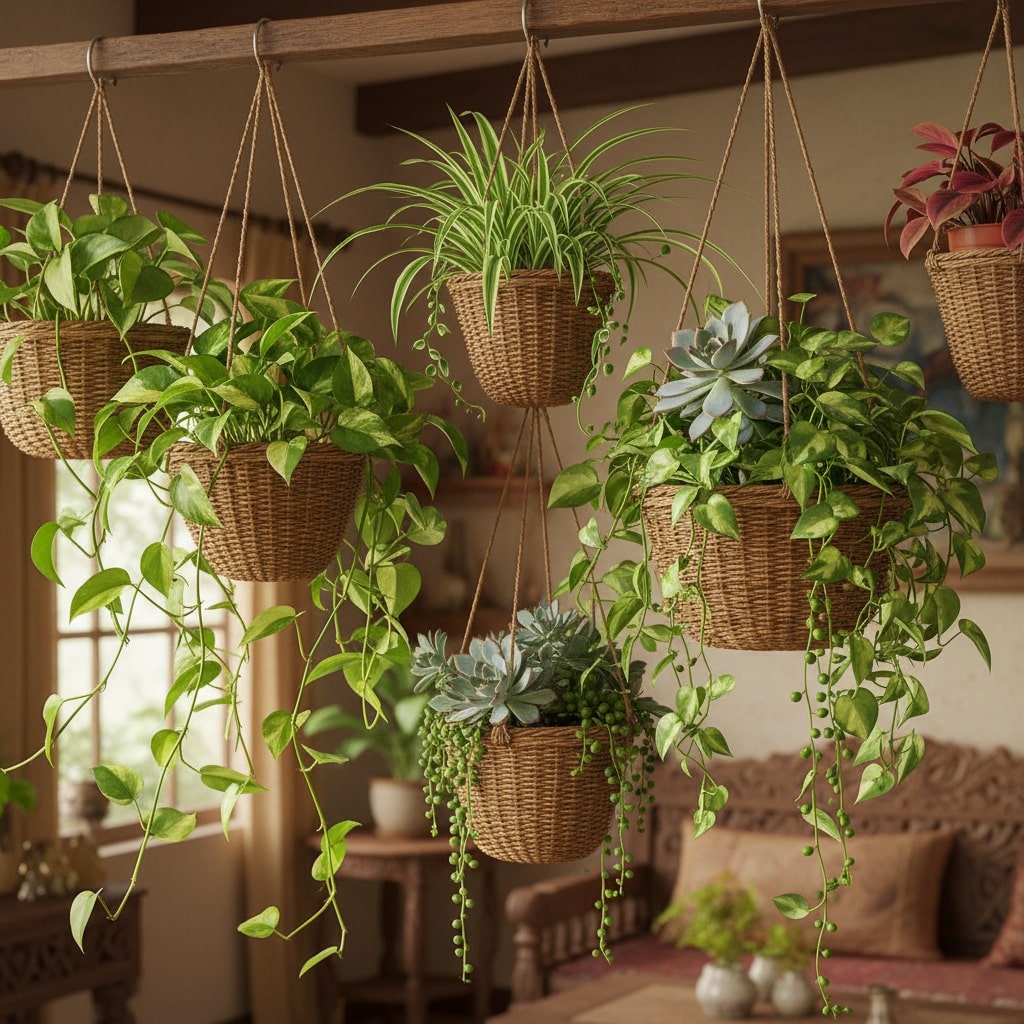
FAQ: Quick Answers for Beginners
Q1: What plants grow best in a jute hanging planter for Indian homes?
A: Money plant, pothos, spider plant, and succulents are hardy and low-maintenance choices.
Q2: How to prevent jute rope from rotting during monsoon?
A: Use pot liners, avoid direct water on cords, and dry ropes in sunlight after rain exposure.
Q3: Can I wash or clean the jute hanger if dusty?
A: Gently brush off dust or use an air blower; avoid soaking or washing.
Q4: How much weight can a jute rope plant hanger safely hold?
A: Generally, jute rope can hold up to 3-5 kg; ensure secure knots and strong ceiling hooks for heavier pots.
Q5: Is macrame technique difficult for beginners?
A: Not at all! Simple knots like overhand and square knots are easy to learn and tutorials are abundant.
Q6: How long does a jute hanging planter last in the Indian climate?
A: With proper maintenance, 1-3 years; monsoons shorten lifespan without care.
Q7: Can I customize my jute hanging planter with colors and beads?
A: Absolutely! Incorporate colored strings, beads, or fabric strips to personalize.
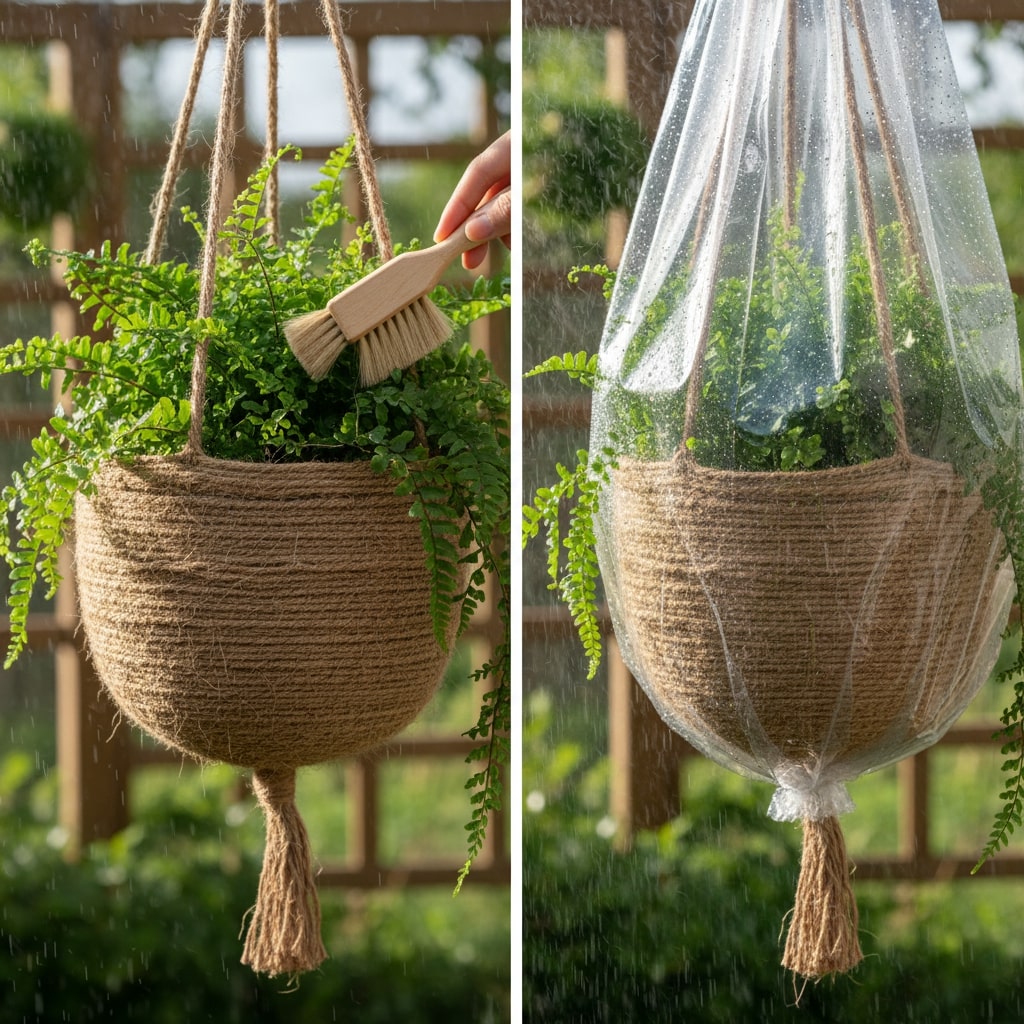
Conclusion: Your Green Journey Begins Here!
I hope this detailed guide on how to make jute hanging planter inspires you to dive into your own DIY adventure. Jute hangers beautifully blend eco-consciousness with Indian aesthetics while maximizing space and adding warmth to your home. Remember, every handmade planter is unique—so don’t worry about perfection. Let your creativity flow and enjoy watching your plants flourish!
Share your creations with friends or on social media to spread the joy. If you want more gardening ideas, explore my posts on balcony fruit and vegetable gardens and DIY gardening projects. Happy crafting from my home to yours!
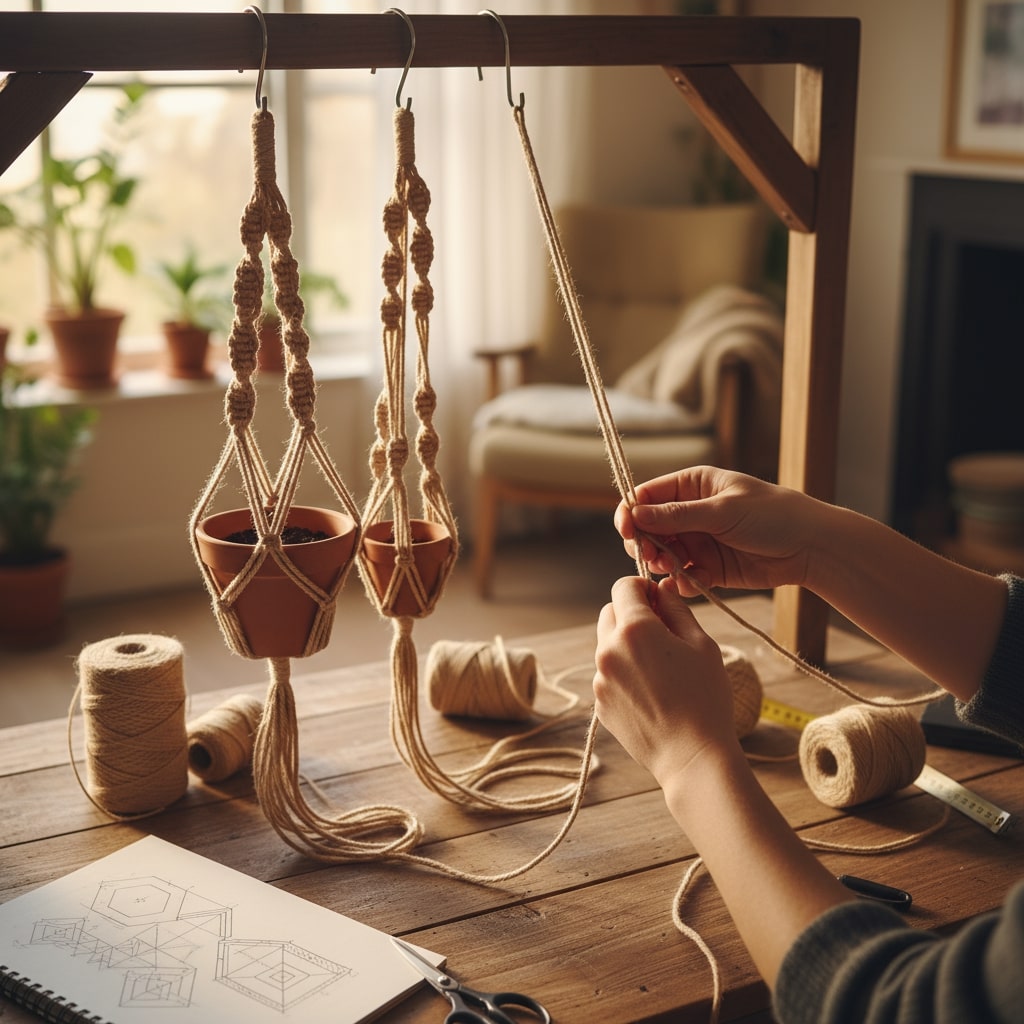
About the Author: Zaid Ansari
Hi, I’m Zaid Ansari — a passionate Indian DIY enthusiast and advocate of eco-friendly living. I believe small crafts like jute hanging planters connect us to nature and bring joy inside our homes. Through simple projects, I love inspiring beginners to create beautiful, sustainable spaces. Connect with me for more fun DIY ideas!